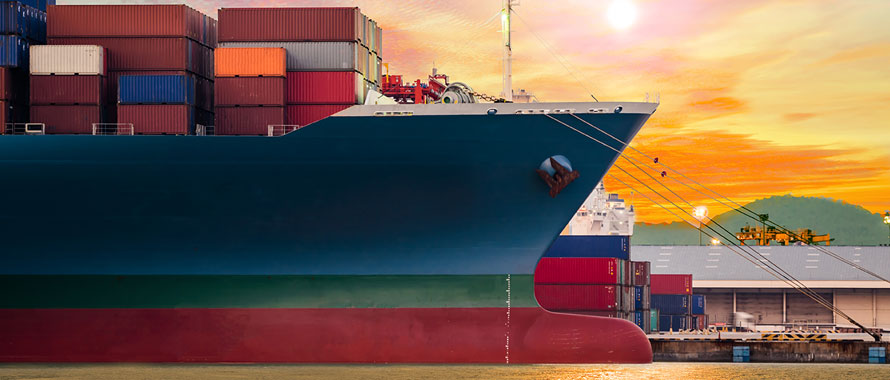The third quarter of 2017 has experienced record-breaking severe weather. This year’s hurricane season is one of only six years to feature at least two Category 5 hurricanes: Irma and Maria.1 Remediation from perils such as these and other acts of nature including floods, windstorms and earthquakes can be a costly endeavor—making Commercial Marine insurance crucial, especially for cargo being shipped on ocean going vessels.
With expert guidance from Patrick Barco, National Product Leader, Marine Centre of Excellence, Burns & Wilcox Canada, Insurance Market Source has developed a checklist of questions for brokers to ask their clients working in the marine industry to ensure proper cargo coverage.
□ What is the client transporting?
Commercial Marine policies insure everything in transit from general merchandise to livestock, and it is imperative that brokers understand what their client is transporting from one port to another. Rates are predicated on the type of product being transported. Clients oftentimes ship flammable products, presenting an increased risk of fire.
□ How is the cargo being packed?
An underwriter who is relatively novice in terms of Commercial Marine insurance will analyze risks based on what is on the application form, whereas more experienced underwriters will analyze risk based on extended factors. How cargo is packed is of significant importance in analyzing exposures. For instance, clients who ship steel coils loaded in a standard container have to professionally lash, secure, block and brace the cargo. Failure to do so could result in the heavy coils rolling into the walls of the container, thus causing extensive damage to the goods and the container.
□ Where on the ship will the cargo be transported?
Another effective topic to discuss with clients is where on the ship the cargo will be transported. If it is on the deck of the vessel, then that exposes the client to a more significant peril and they may not have adequate insurance.
□ What routes are clients taking when transporting cargo?
Travelling across the high seas can expose clients to hazardous elements, which can damage the cargo, the containers, and the vessel. In cases of extreme weather that compromises the vessel – perhaps a threat of sinking – captains have authority to safeguard the vessel by declaring “General Average,” which is a sacrifice. Captains can lighten and stabilize vessels by off-loading containers that are directly on deck in order to safely make the voyage. General Average Adjusters are then appointed to determine the contribution from all cargo owners, whether they were affected by the declaration or not.
□ Are the clients travelling through high-risk areas?
Clients travelling to certain destinations may face piracy. There is a designated high-risk area (HRA) off the coasts of Somalia, where ships often experience hijacking. The State of Maritime Piracy 2016 Report claims the economic cost of piracy caused by groups in Somalia increased from $1.3 billion in 2015 to $1.7 billion in 2016, including costs paid by shipping operators for increased insurance, labor, armed guards and other protection measures, as well as ransom payment and the costs of naval deployments.2 The maritime industry has also experienced an increase in piracy when crossing the Strait of Hormuz. Moreover, attacks have also surged off the coast of West Africa resulting in economic losses increasing by more than 10 percent to $793.7 million for that area alone.3 Commercial Marine insurance policies are typically paid per transit, and underwriters often charge additional premium for trips through high-risk areas.4
Brokers and agents should ensure their clients have technology keeping them abreast of gale-force winds or other severe weather and are adequately preparing their vessels if they must travel paths that cross HRAs, when insuring ship-owner fleets.
□ Is the client’s vessel certified?
Every policy is subject to an Institute Classification Clause mandating that a vessel be registered through the Veritas or American Bureau of Shipping (ABS). This classification is a dry dock survey that verifies whether vessels are seaworthy and in an adequate condition to take the intended voyage. In the cargo industry, it is common to see old vessels. These older vessels are subjected to significant shocks from forceful winds and waves that continuously weaken the ships during various voyages. In some instances, wear and tear over time has resulted in vessels splitting down the middle. In other cases, older vessels can experience malfunctions in machinery and break down mid-voyage and then need to be towed to the nearest port. This could involve in-cargo and hull losses.
EXPERT ADVICE
Commercial Marine insurance has many niches, and perils facing clients looking to insure commercial vessels such as cargo ships, fishing guides, luxury yachts, barges or floating restaurants can be very different. A keen understanding of several factors including the client’s business needs and the maritime industry as a whole is paramount. Brokers should consider partnering with experienced insurance professionals that understand these complexities—fortifying a broker’s ability to foster and protect relationships with clients when educating them on the various risks accompanied with operating in the commercial marine industry.
References:


